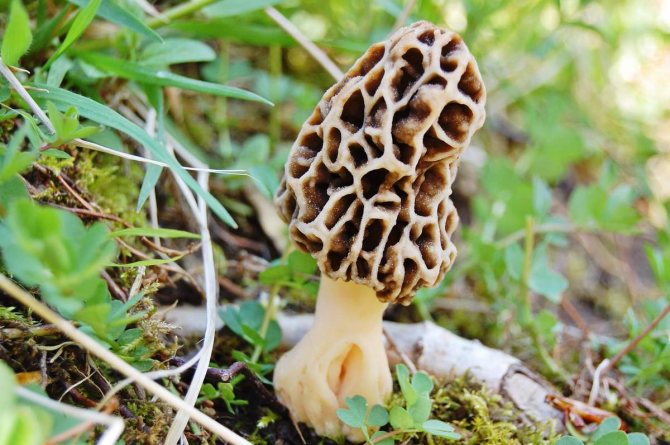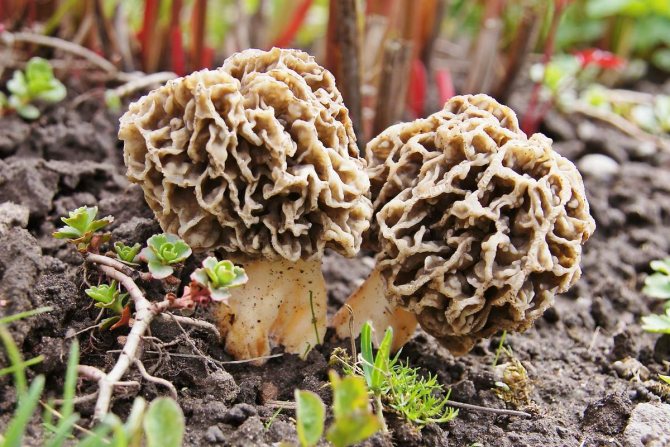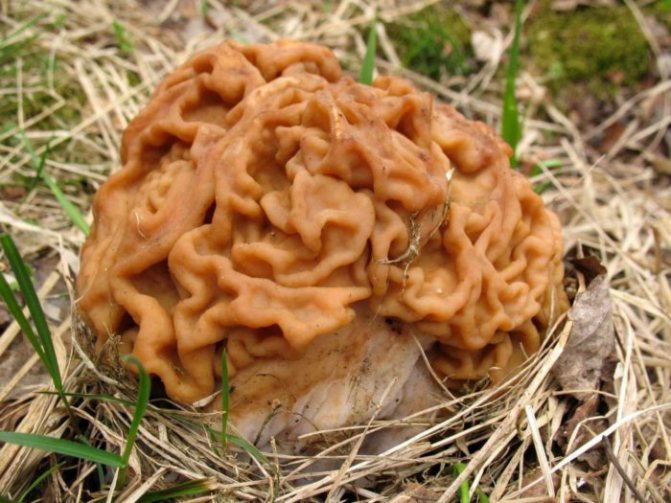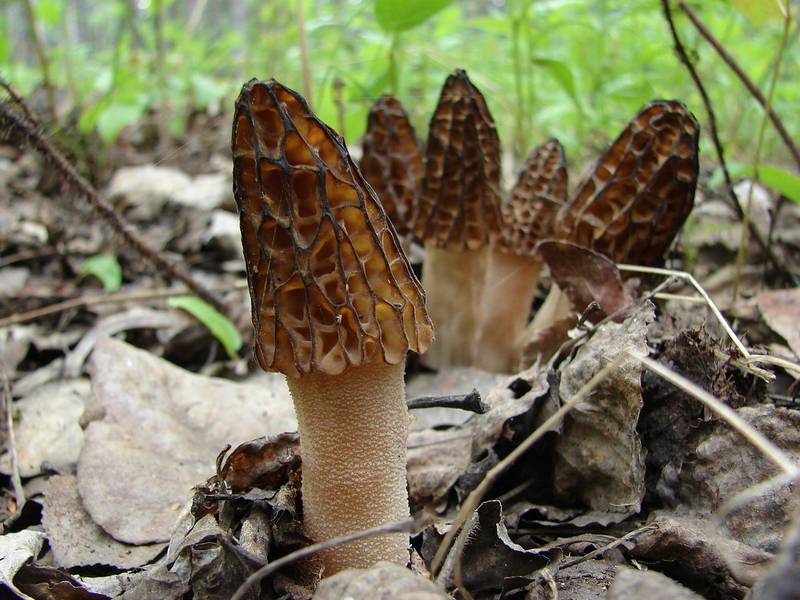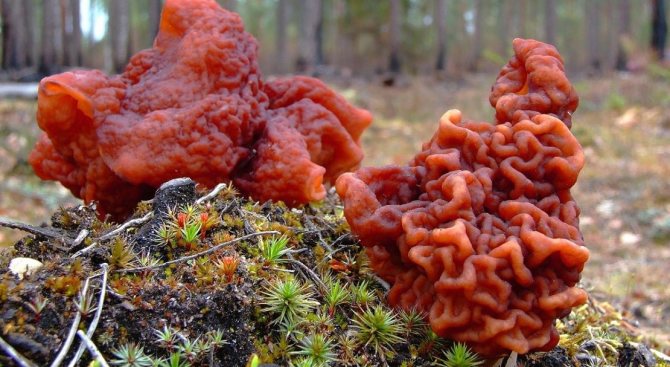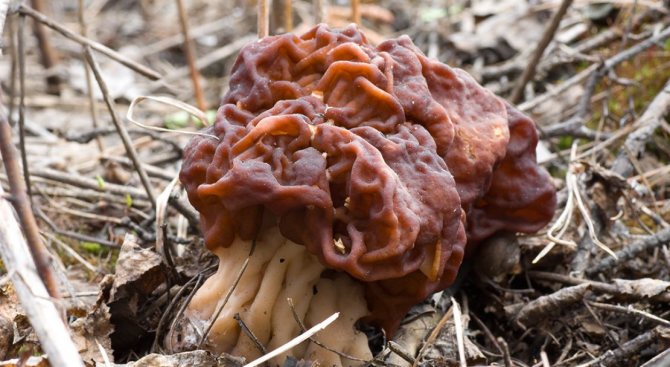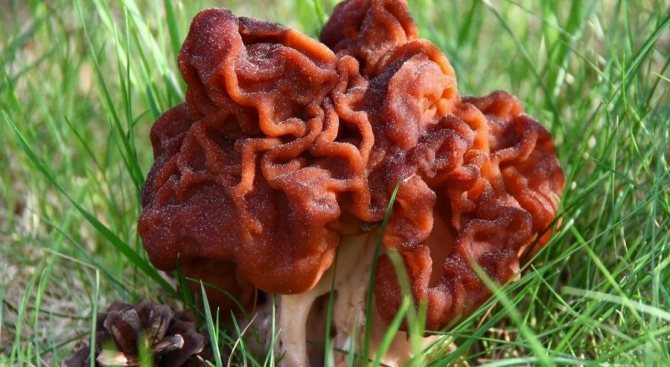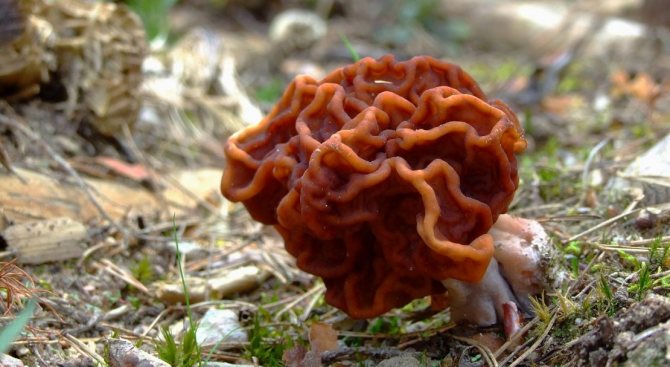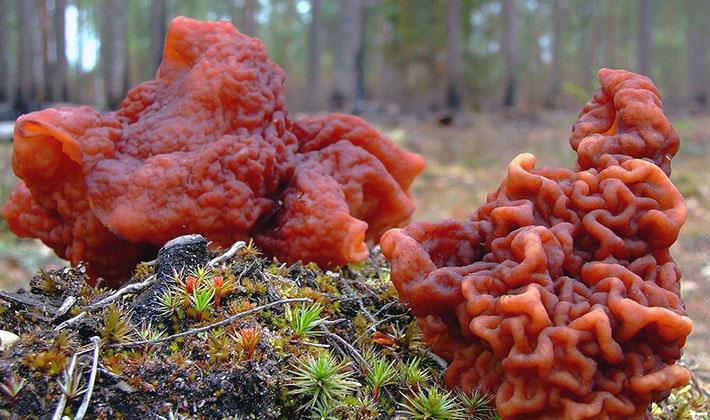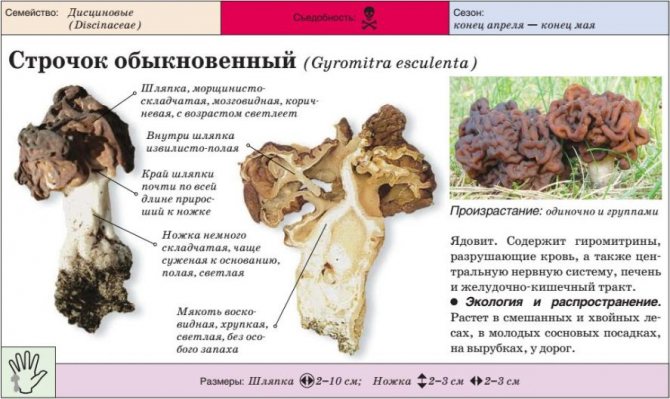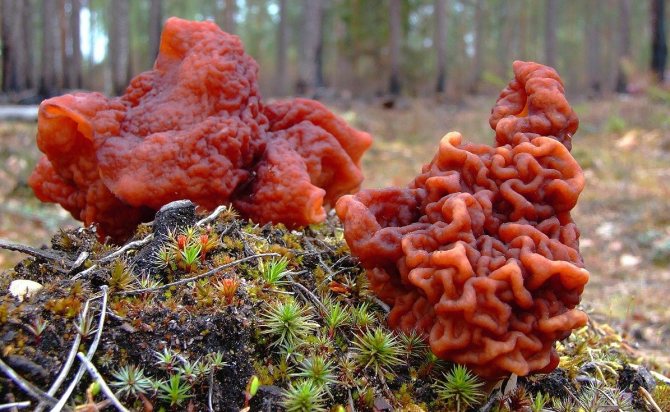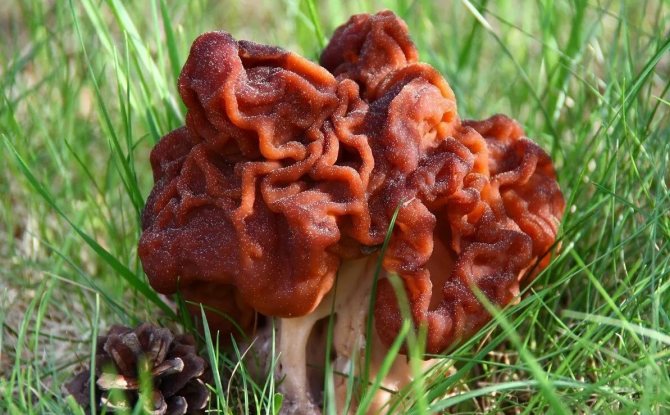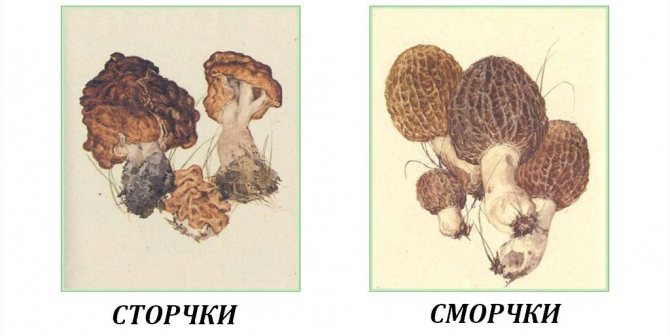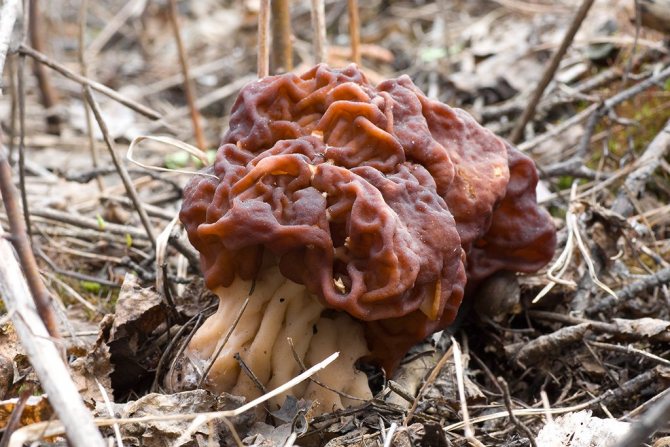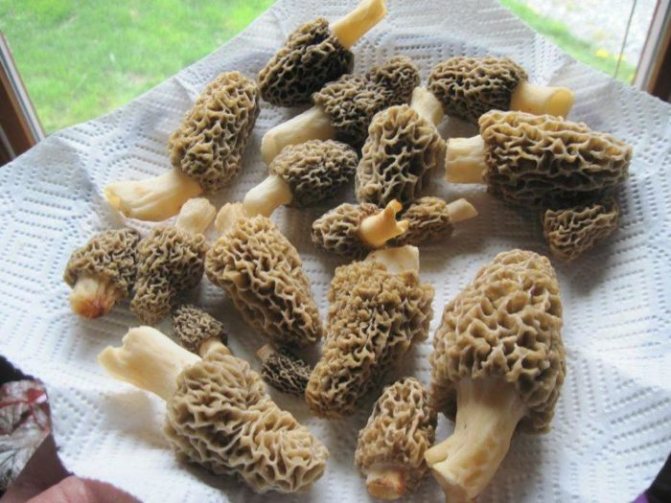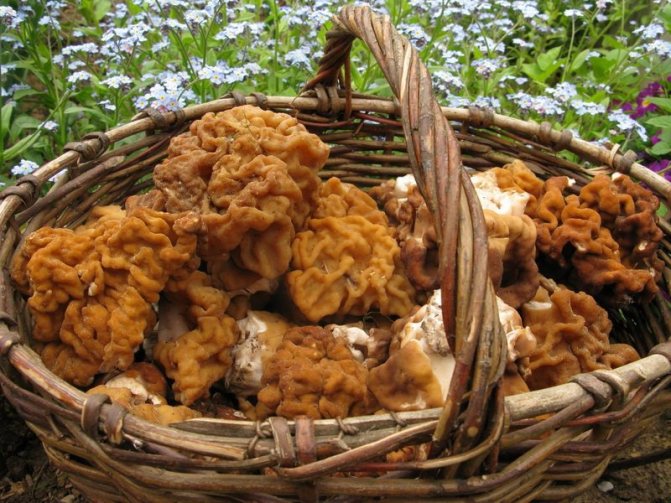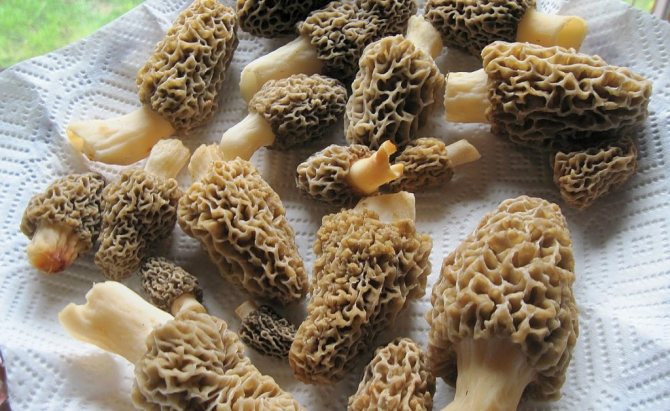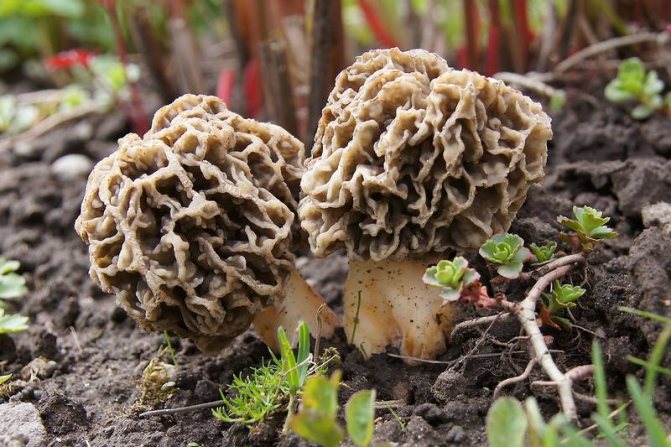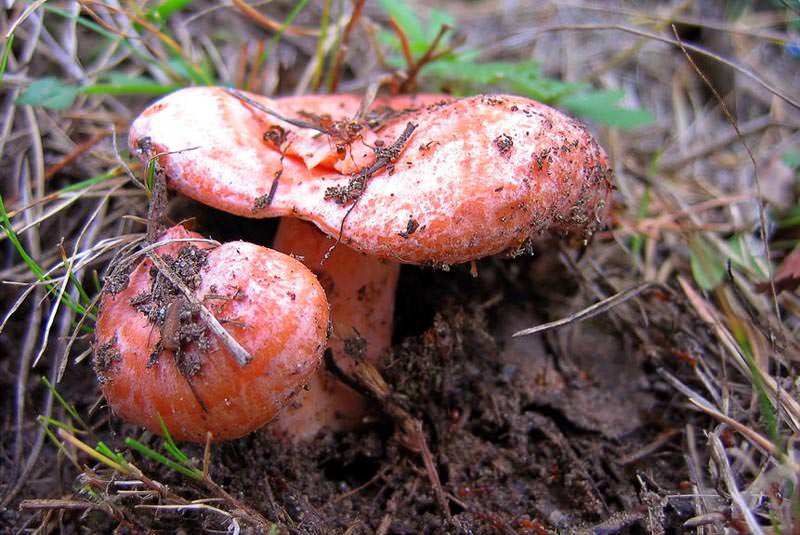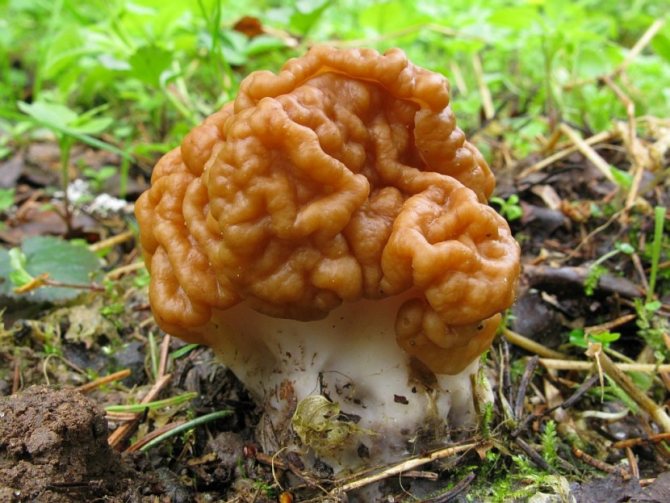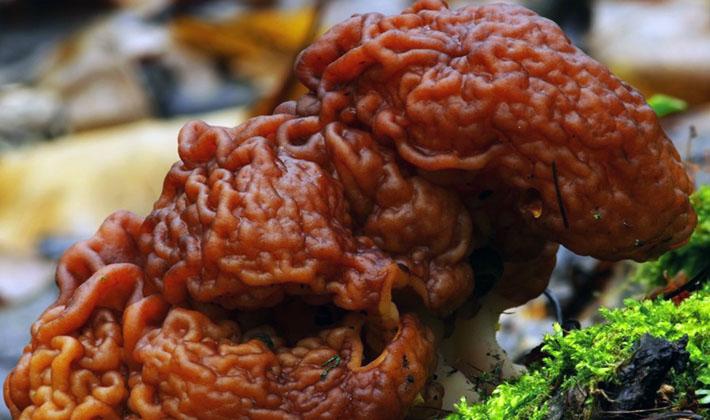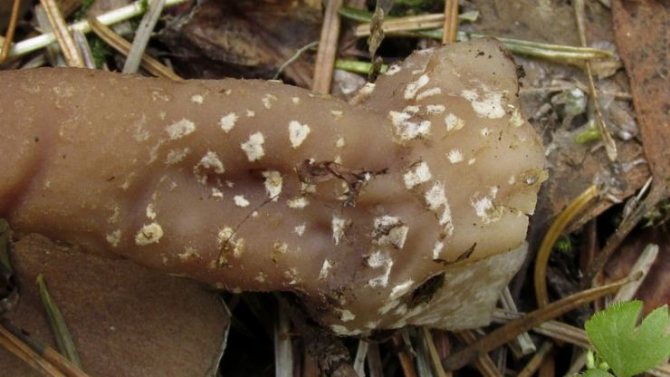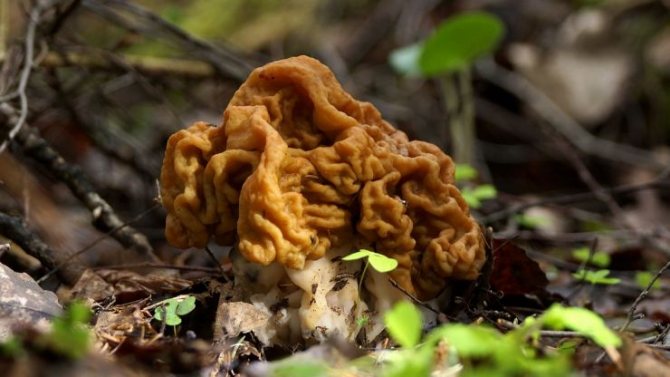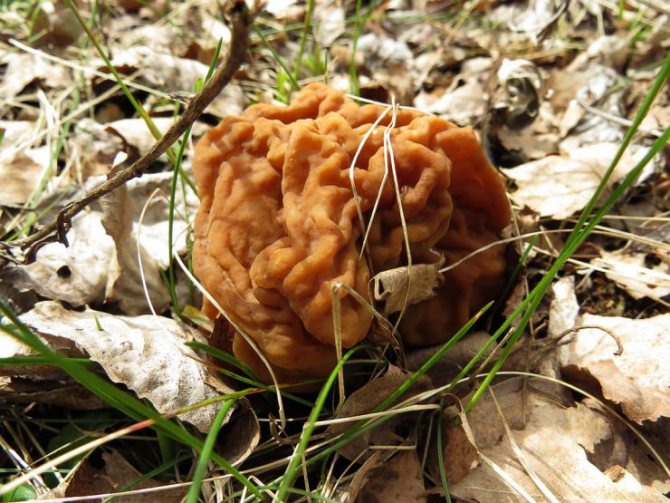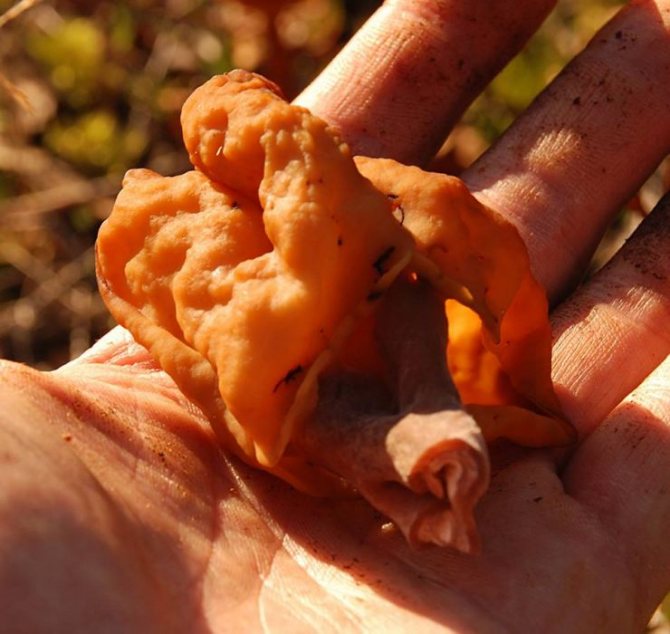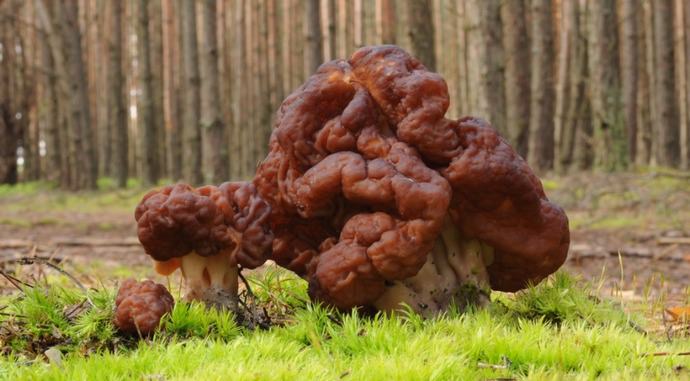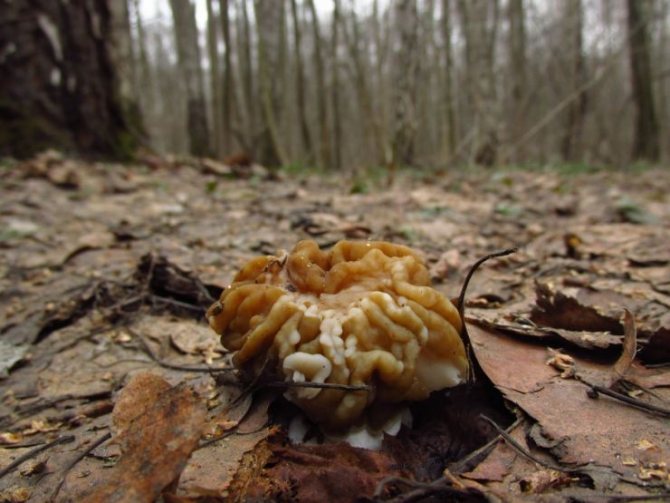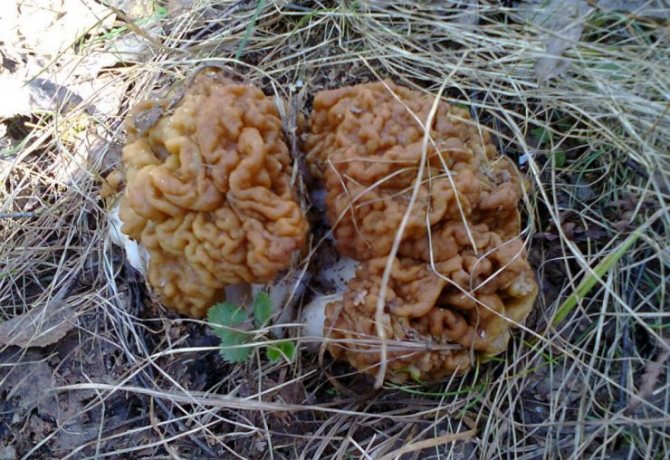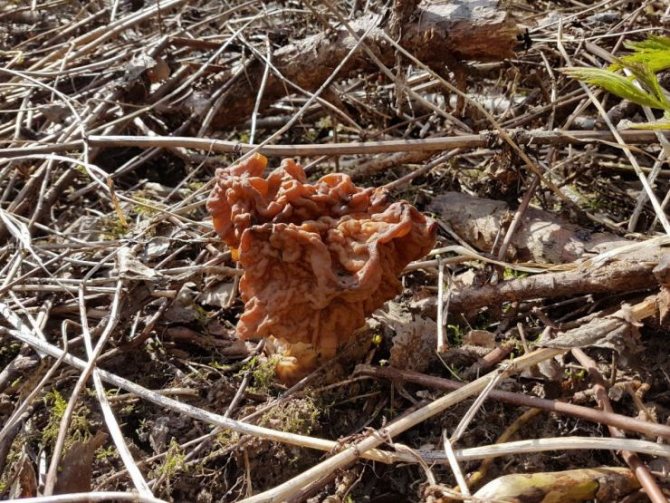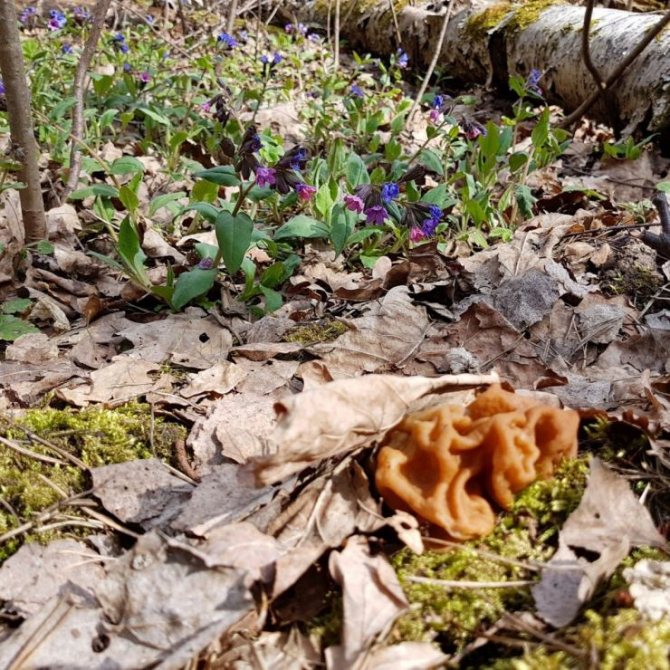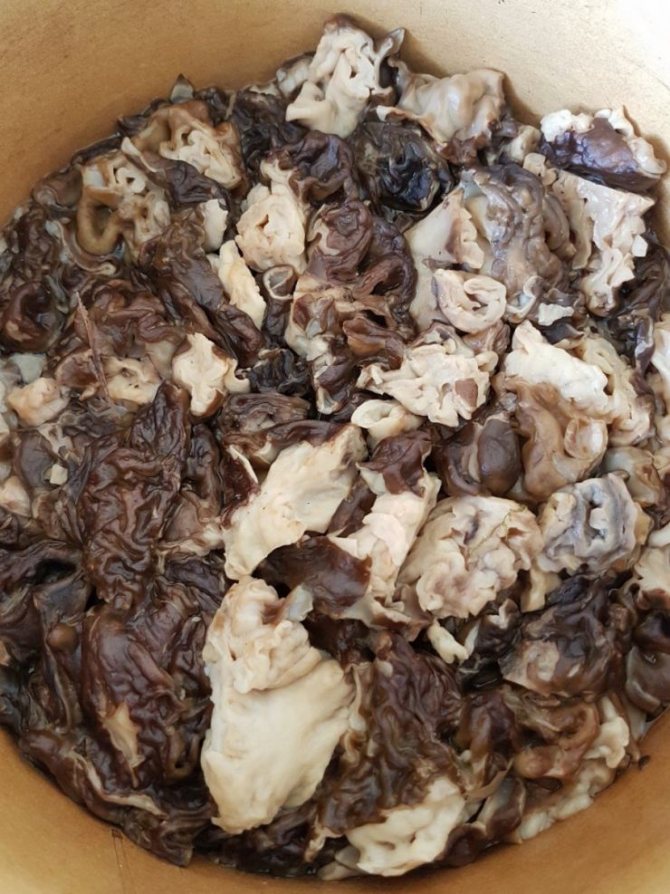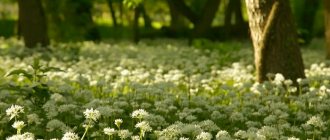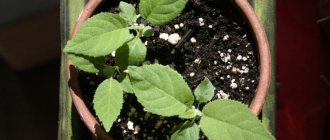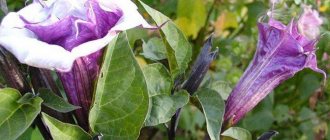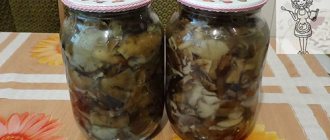03.12.2018
Morel is the first spring mushroom found in the forest at the end of April. The mushroom is delicious, has a special aroma, you can cook many original dishes from it. The Latin name is Morchella. But not everyone knows where and when morels are harvested, what time of the year, how to find them and distinguish them from poisonous and dangerous lines.

When morels are harvested
Description of appearance
This is a typical representative of morels with a rounded brown cap and light shades of stem. Appears earlier than most other mushrooms - in April, sometimes at the end of March.
Hat
The stem and cap of the morel stand out visually, but in fact they form a single fruit body. It is quite large (up to 15-20 cm in height), seemingly massive, although in fact it weighs very little. The fact is that the body is hollow inside, therefore, to prepare a dish, you need to collect quite a lot of such mushrooms.
The shape of the cap is round, resembling an egg, sometimes flattened. The color can be quite different: there are representatives with brown, orange caps, but there are also options for gray and dark brown colors. This is what makes it difficult to collect morels: it practically merges with last year's leaves and becomes little noticeable.
On the surface of the cap, convolutions and grooves are noticeable. They form peculiar cells of different sizes with irregular shapes. The folds of the cells are colored in lighter shades.
Leg
It has a regular cylindrical shape, slightly thickens towards the base. It looks massive, but is hollow inside, so it breaks easily even with slight squeezing. It grows to a height of 7-9 cm, and reaches 2-3 cm in diameter.
It has a light color, but with age it becomes brown and begins to become covered with flakes. The surface is smooth, but may have longitudinal grooves closer to the lower edge.
Spore powder
Has light orange or yellowish tints. Spores resemble an ellipse in shape, granular in structure.
How dangerous can morels be?
Morels, like stitches, contain a dangerous substance called gyromitrin. But there is much more of this substance in the lines than in morels or morels. Some researchers are confident that morels grow in many areas, which do not contain the toxin.
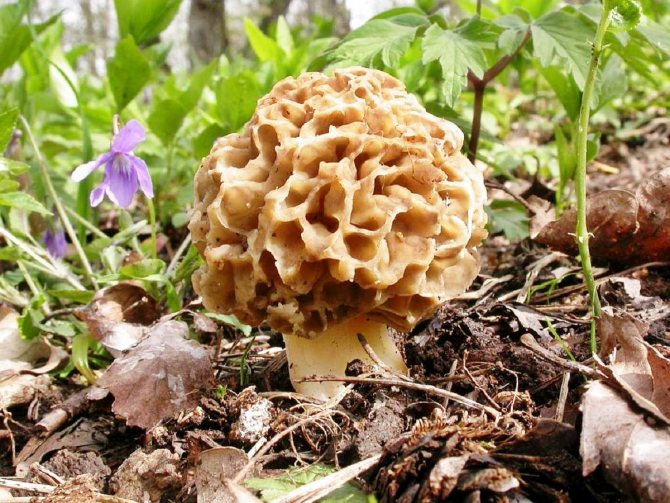

In any case, it is recommended to pre-scald, but it is better to boil morels, and then drain the water. In this case, the mushroom will delight you with its taste and will not cause any harm.
A dangerous resemblance, or how to distinguish an edible morel from a line?
Some mushroom pickers confuse morels with their poisonous cousins. Indeed, related species are very similar, but they can be distinguished due to their shape, it is worth paying attention to the fact that the cap of the edible morel is round, in addition, its size is larger than that of poisonous species.
In the morel, the length of the cap and the legs are almost the same, and in the stitching, the leg is often shortened, sometimes it is not visible at all.


In morels, both the cap and the leg are hollow inside, and the lines are filled with winding pulp. There are sinuous cells on the surface of the morel.
Mushroom spread
It is a very famous mushroom that is found throughout the Northern Hemisphere. Also introduced to North America, even found in Australia.
He chooses a temperate climate zone, prefers humid, well-lit places:
- Parks and gardens
- Bereznyaki
- Deciduous forests
- Mixed forests
It grows next to willows, poplars, birches and other deciduous trees, as well as in river floodplains. The mushroom appears already at the end of March and begins to grow especially actively in April. However, morels can be found in Russia not earlier than the first half of May.
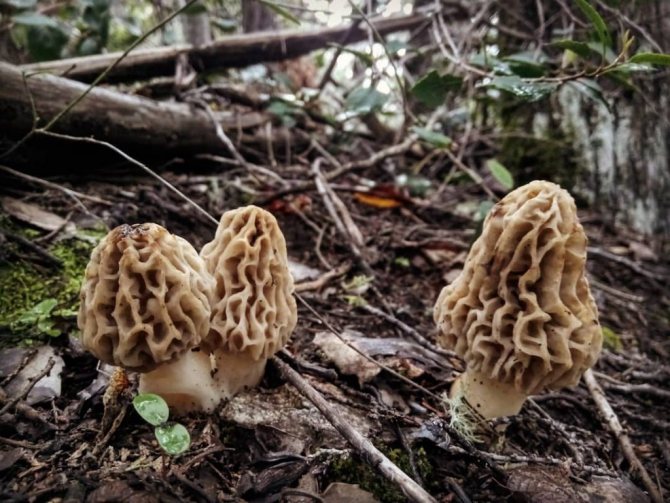

Fruiting mainly until the end of June. However, if autumn is warm and humid, it can occur even in the first half of October.
Edible mushroom black morel (with photo)
The edible mushroom black morel has fragile fruiting bodies 5-12 cm high, 4-7 cm wide. Cellular conical, ovoid or pear-shaped cap, occupying 2/3 of the mushroom height, dark brown or black with light brown cells. The leg is hollow, fragile, white with a granular surface. The pulp is fragile, not bitter or pungent. There is no milky juice.
Look at the photo of edible morel mushrooms and remember how they look to distinguish them from poisonous species:
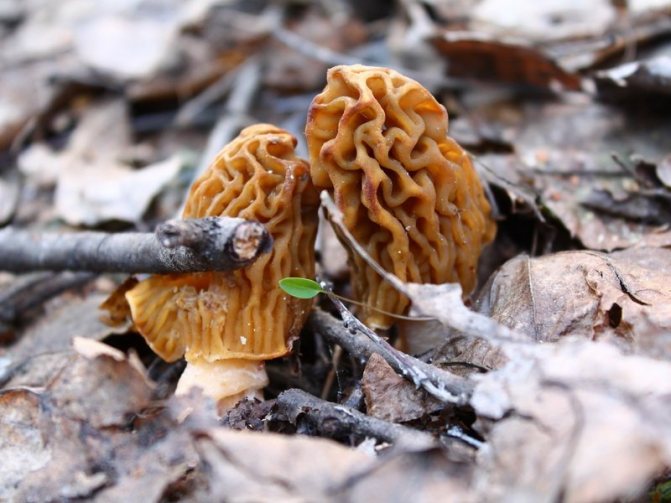

Morel mushroom growing in a mixed forest


Edible mushroom black morel
Grows in coniferous and mixed forest. Prefers limestone soil. Black morel is found in early spring. In central Russia, its fruiting falls on May 10-20, immediately after the wave of fruiting lines. Black morel is quickly damaged by mushroom gnats ("worms"), so you need to have time to collect it immediately after the start of fruiting. Produces abundantly in pine forests after their fires. It grows on or near fireplaces. Black morel has no poisonous counterparts. No pre-boiling is required. It tastes best after boiling for 10 minutes.
Similar species
The appearance of this mushroom is very remarkable, so it is almost impossible to confuse it with any poisonous variety.
At the same time, the real morel is similar to closely related representatives:
- Co conical morel it is united by the similarity of shape, but the latter is distinguished by a more rounded hat.
- A similar difference is possessed by high morel.
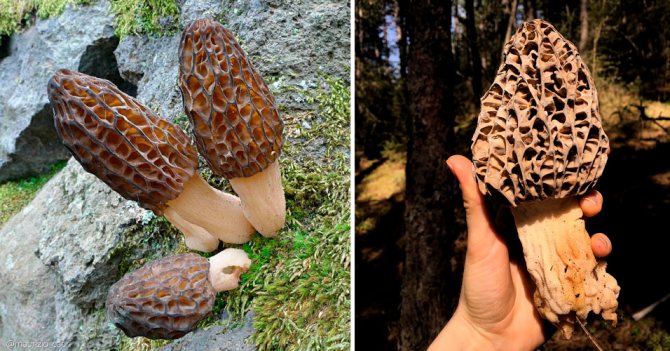

1- Morel conical 2- High morel
Growing morels at home
Morels are more often saprophytes (that is, a dead substrate of organic origin serves as a food source for them). Some species are capable of forming mycorrhiza with higher plants, with coniferous or deciduous trees.
People introduced saprophytic species of morels into culture and developed several methods of their cultivation. For example, in France, saprophytes growing under fallen apples are successfully bred in the open field. There have also been attempts to grow morels in greenhouses on an industrial scale, but they have not yet been crowned with success.
Mushrooms that grow well on burnt-out areas have learned to grow in Germany by filling pieces of mycelium with wood ash or paper ash buried in the soil. As fertilizer, cow dung, well-rotted compost or humus are used. In the fall, the mushroom plantation is covered with fallen leaves or straw mats, which are removed in the spring.
You can try another way of growing morels: put mushroom caps in a bucket of warm rainwater and shake well. The resulting solution should be poured over the prepared bed. This work is best done in cloudy damp weather in April-May. It is recommended to mulch the ridges with humus and cover them with sawdust or old bark until next spring. Under favorable conditions, mushrooms will appear on them next year. The optimum soil temperature for the growth of morels is 15-16 ° C.
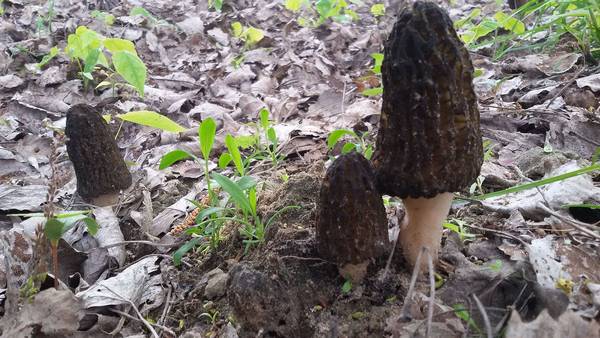

Photo by: Grzegorz Browarski, CC BY-SA 4.0
Edibility
The pulp has a rather pleasant taste, but at the same time, the mushroom aroma is weak. The mushroom does not differ in high taste, therefore it belongs to the category of conditionally edible. Previously, it must be boiled for 15 minutes, and the resulting broth is drained. Also suitable for drying.


Stitching mushrooms: benefits and harms, contraindications
Useful qualities of mushroom stitches
There is such a term as "fungotherapy", that is, treatment with mushrooms. As practice shows, line mushrooms are not used often enough, but recently this direction has been actively developing. The lines have a large number of positive qualities and different chemical compounds. The property of the mushroom is capable of:
- Increase appetite
- Relieve pain
- Tone up
- Benefit during neuralgia
- Heal many eye diseases such as glaucoma, hyperopia and so on
- Improve digestion
- Improve the functionality of the pancreas
The harm of mushroom stitches
Since the lines contain poisons and toxins, even after normal processing of the mushrooms, they do not always disappear. Therefore, if you do something wrong, you may face serious problems.
- Even if significant poisoning is not detected, carcinogens and gyromitrin poisons will not benefit the body when ingested. They always remain inside the stitches, even if boiled or dried.
- Some people are hypersensitive to gyromitrins. Therefore, even the smallest dose of the toxin can cause serious consequences.
- In nature, you can meet such representatives of these line fungi, from which all toxins cannot be eliminated.
- This cannot be done even if the lines are boiled or dried for a long time.
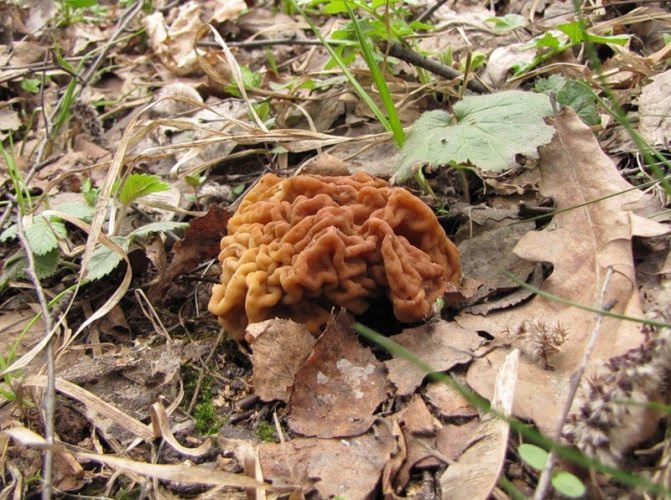

Have beneficial and harmful qualities
Many researchers argue that boiling stitches just once is not enough. They argue that mushrooms must be boiled at least 3 times, each time in new water for 10 minutes. In addition, you need to thoroughly rinse the lines after boiling.
But it is better in life to be careful and not risk your health in vain..
Contraindications
- The giant lines have milky qualities, but despite this mushrooms contraindicated women who are breastfeeding.
- Prohibited eat these mushrooms for children who are not yet 12 years old.
- Not recommended use lines for a person who has reduced blood clotting, low hemoglobin. In addition, you can not eat mushrooms for people who suffer from liver and kidney disease.
- Prohibited eat mushrooms for people who have an increased appetite.
- In some cases, there is an intolerance to the chemical components that are present in the lines.
- And most importantly, doctors categorically forbid include lines in the diet for people with pulmonary and heart failure.
Interesting Facts
- The cells that run along the surface of the morel cap are a bit like a honeycomb. Therefore, in English this mushroom is called "honeycomb morel", which literally translates as "honeycomb morel". The fungus is not picky about environmental conditions. Therefore, it can settle not only in forests, but also in city parks and even in landfills, next to garages, etc.
- Morel managed to spread so widely throughout the world that it even became an official mushroom - such a title was awarded to it in the state of Minnesota (USA).
Morel poisoning: symptoms and first aid
Old, raw and improperly cooked morels can be poisoned. Symptoms of toxicosis begin to appear approximately 6 hours after eating the mushrooms. First appear:
- stomach pain
- nausea,
- vomiting of bile,
- heart palpitations,
- diarrhea,
- headache.
Depending on the age and state of health of the affected person, poisoning with morels may be harder or easier to tolerate. Further spread of the poison through the body leads to the destruction of red blood cells and, as a result:
- to weakness,
- drowsiness
- dizziness
- blanching of the skin.
If after this help is not provided, then after a day the poison of morels will provoke the destruction of liver cells, damage to the kidneys and urinary tract. There will be discomfort during urination.
The third stage is the effect of toxins on the nervous system:
- the poisoned person becomes inadequate,
- he has convulsions, hallucinations,
- he may fall into a coma.
Mushroom poisoning can last from a day to 2 weeks, depending on the state of the person's immune system. Morels contain a large amount of bilirubin, so poisoning may additionally be accompanied by yellowing of the skin.
There is no antidote against the morel toxin, and the poison must be removed from the body mechanically. In this case, the following procedures will help:
- gastric lavage,
- cleansing enemas,
- taking activated carbon or other sorbent,
- drinking a lot of warm liquid,
- and it is imperative to call a doctor to continue the necessary treatment.


Photo by: Dish of morels photo, CC BY-SA 3.0
The use of mushrooms for medicinal purposes
From the lines, you can prepare an alcoholic tincture. To do this, you need to take 30 g of dried mushroom pulp and ½ liter of vodka. Insist the mixture in a cool dark place for 2 weeks, then strain and pour into a glass container.
The drug is used in several ways:
- Rubbing. The tincture is used for arthrosis, osteochondrosis, neuralgia, arthralgia and other conditions accompanied by pain and inflammation of bones, joints, ligaments. After thoroughly rubbing the affected area, you need to tie it with a warm cloth or handkerchief. The tincture can be used no more than 3 times per day.
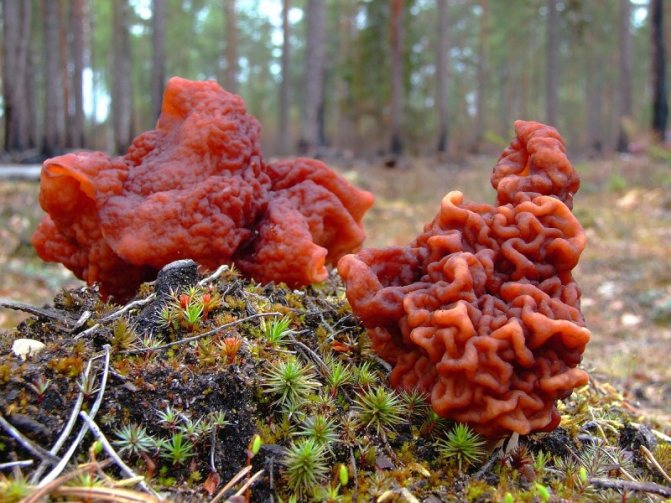

- Ingestion. The tool is used to treat pancreatitis and pancreatic diseases. For this, the alcohol extract is diluted in equal proportions with liquid honey. You need to take 5 ml of the product per day. The course of therapy can be continued for no more than 14 days.
It is worth remembering that treatment with a tincture of stitching is unsafe and can cause side reactions. If a skin rash appears, the state of health has worsened or other ailments after using the home drug, its further use is strictly prohibited.
The lines have a lot of useful properties that are successfully used in folk medicine. If you exercise caution, properly prepare the product and use it for the manufacture of home medicines, and also do not neglect contraindications, then it will not harm your health.
What does an ordinary line look like
Habitats of common lines (Gyromitra esculenta): on sandy soil in mixed forests, among grass and next to rotting wood, they grow in small groups or singly.
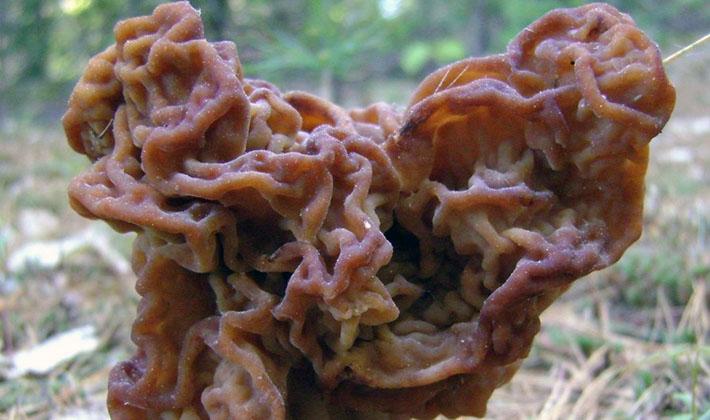

Season: April May.
The hat has a diameter of 3-10 cm, a spherical shape. A distinctive feature of the species is a shapeless, cerebral-folded cap of a dark chestnut or brownish brown color. A hat, sometimes adhered to a leg.
The leg is short, thick, 2-6 cm high, 15-30 mm thick, grooved or folded, hollow, at first white, later ivory, has longitudinal notches.
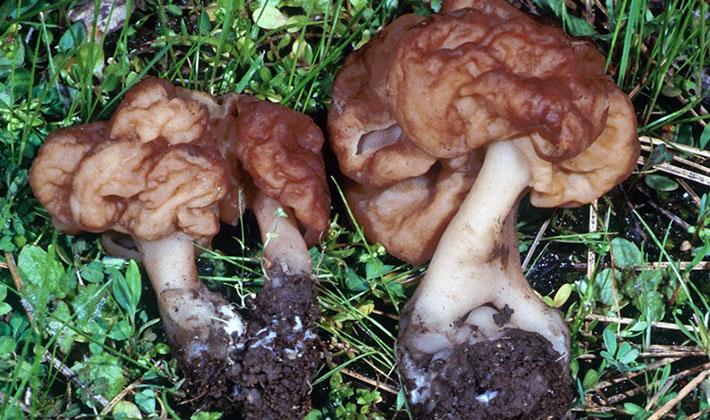

Pulp: whitish, tough, without any special taste or smell.
Plates. The leg in the upper part immediately passes into the cap, so there are no plates as such.


Variability. The color of the cap varies from brown-chestnut to pink-chestnut and brown-brown.
Similar species. The description of the inedible ordinary line differs from the edible giant line (Gyromitra gigas).The giant has a massive oval or irregular leg with a section larger than the height of the mushroom.
Poisonous, toxic.
Here you can see a photo of both types of line mushrooms, the description of which is presented above:
Nutritional value of morels
The nutritional value of morels is only 20 kcal per 100 g.
Fresh mushroom (100 g) contains:
- 2.9 g protein;
- 2 g carbohydrate;
- 0.4 g fat.
The main share is water - 92 g, it also contains dietary fiber - 0.7 g. Of the minerals it contains potassium, magnesium, calcium, phosphorus, sodium, iron and vitamins C, B1, B2, PP, D.
Morels are the first spring mushrooms that are harvested in April - May.
Benefit
Mushrooms contain various substances that make them an excellent ingredient used in folk medicine and have the following effects:
- maintaining tone;
- relieving pain;
- increased appetite;
- stabilization of the spleen's performance;
- improvement of the digestive tract.
Why morels are useful
Since ancient times, representatives of morels have been used to treat eye diseases, improve myopia and age-related hyperopia. The composition contains substances that strengthen the eye muscles and protect the lens from clouding. On the basis of these fungi, drugs are being developed to combat cataracts.
In folk medicine, the product is used to treat diseases of the stomach and intestines. Tincture of these mushrooms is a good remedy for conjunctivitis. The pulp also contains polysaccharides, which suppress the activity of cancer cells and viruses, and stimulate the immune system.
Application and processing
Dried morels are used to make mushroom powder, which is a natural flavoring agent. It is added to various dishes. Dried mushrooms absorb moisture quickly, so they are stored in paper bags or cardboard boxes in a dry place, otherwise they will become moldy. They are not salted or pickled.
Morels processing:
- mushrooms are cleaned, washed thoroughly;
- soaked in water for 1 hour;
- boil in water - 30 minutes;
- washed with hot water;
- the mushroom is ready to use or eat.
Morels are the first spring mushrooms, which, despite their low nutritional value, are very tasty. They should not be used by people who have individual intolerance, children under 12 years old, pregnant and lactating women, as well as people with severe cardiovascular diseases.
0
How to use it correctly?
Morels must be properly processed before cooking:
- Go through the collected mushrooms, cut off the tips of the legs.
- Place the mushrooms in a large bowl and cover with clean water.
- Soak them in water for two hours.
- During this time, stir 3-4 times.
- After that, rinse the morels three times, changing the water all the time.
- Transfer to a saucepan, add water, salt, bring to a boil, cook for 10 minutes.
- Drain the water.
- Fill with new water and repeat the procedure.
- Place the cooked morels in a colander.
- Allow excess water to drain.
After that, mushrooms can be used for the first courses, fried, stewed, used in fillings, and cooked mushroom caviar.
If further cooking involves frying in oil, cover the pan with a lid to avoid splashing hot liquid.
Where do morels grow?
They grow in any forest. At the same time, different species prefer certain trees, for example:
- Conical morel, more often found in pine forests, less often in deciduous forests. Prefers felling, shrubs, willows, but can grow in the garden, in the field.
- Gray giant morel not so whimsical to soil and terrain - it even settles in clay wastelands. It is found in poplar groves and in shelter belts.
- Morel cap... Avoids shadows. In early May, it grows in burnt-out areas, glades, near roads.
Growing conditions:
- They love moisture. At high humidity, they grow even in a treeless desert.
- In early spring, when the soil is moist, the mushroom grows in almost any conditions - you can even find it in your own garden or vineyard.
- If you go for a massive harvest of morels, then it is better to look for them in well-lit glades and on scorched terrain.
Morels, unlike other mushrooms that bear fruit for two to three months, appear for a very short time. As soon as the spring moisture leaves the soil, the morels disappear. They appear only once a year - for a couple of weeks.
In good weather, when it is warm and damp, the harvests are enormous. But few people go in the spring for mushrooms. Therefore, morel families often remain intact. Why aren't they collected? Perhaps due to the fact that they are not outwardly attractive, they grow out of season, and most importantly, many are afraid of poisoning. But if you look at the external signs, then it is unrealistic to confuse edible morels with dangerous lines.
A lover of "quiet hunting" tells how the lines differ from morels, how they grow, and how to look for them:
Places and rules for collecting lines
All varieties are found in coniferous forest plantations, most often under pine trees and in old clearings, areas after a fire and places well warmed by the sun's rays.
- only well-known mushrooms can be picked in the forest;
- you can not eat fruit bodies, the edible qualities of which are in doubt;
- it is forbidden to collect mushrooms in ecologically unfavorable areas, near highways, garbage dumps or industrial facilities;
- it is absolutely impossible to collect overgrown or wormy mushrooms;
- fruiting bodies must be collected in wicker baskets or special wooden boxes.
Also read: Collect, grow, cook: what we know about mushrooms
When collecting lines, you must remember the need to carry out their mandatory boiling before the main preparation for a quarter of an hour. Mushroom broth should not be used for food purposes. The collected fruiting bodies must be sorted and carefully reviewed on the day of collection. Any dubious, old and overgrown, as well as wormy mushrooms are subject to disposal. In the process of the bulkhead, the lower part of the legs is cut off, after which the entire above-ground part is thoroughly washed in running water.
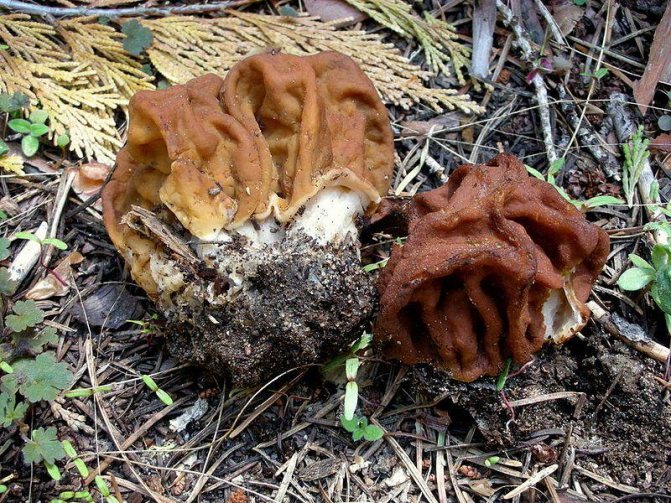

Stitches are found in coniferous forest plantations, most often under pine trees and in old clearings
Contraindications
Lines are categorically contraindicated:
- people with serious diseases of blood vessels and heart;
- pregnant women;
- when breastfeeding an infant;
- children under twelve years old;
- with personal intolerance.
Soup from stitches
To prepare a soup from half a kilogram of mushrooms, you need to take one onion, herbs, 300 g of potatoes and quite a bit of pearl barley or wheat groats. And the lines themselves must be prepared in advance to remove carcinogenic substances as indicated above. Then we continue according to the scenario:


- Pour water into a small saucepan, put on fire. After boiling, add the chopped mushrooms. Cook for 20 minutes.
- Peel potatoes, cut into pieces. Put in broth, add cereal, salt. Cook until potatoes are tender.
- Preheat a frying pan, pour in a little vegetable oil.
- Peel the onion, cut into pieces and fry.
- A few minutes before turning off, put chopped greens, fried onions. Boil for a few minutes.
Read about how to cook a delicious dried mushroom soup here.
Composition and medicinal properties of stitches
The chemical composition and medicinal properties are most often used in the treatment of articular pathologies that can be presented:
- radiculitis;
- polyarthritis;
- osteochondrosis;
- rheumatism;
- overgrown bones;
- pathologies of the feet.
The active ingredient chondroitin facilitates the absorption of fluids by the cartilage tissue and makes it more elastic.
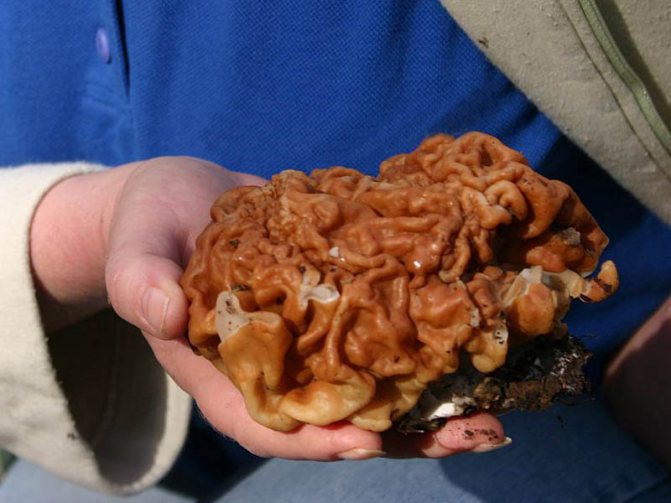

The chemical composition and medicinal properties of stitches are most often used in the treatment of articular pathologies.

